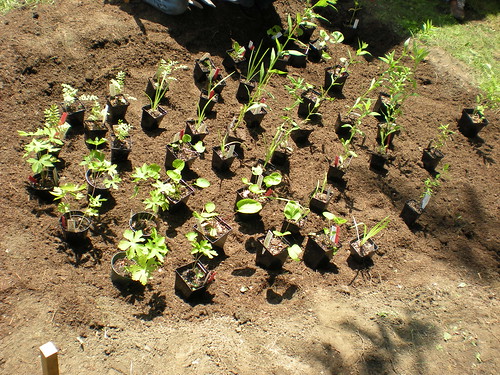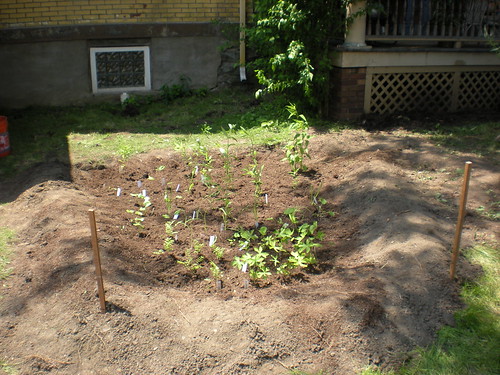As I've mentioned before, a rain garden is a garden intended to capture runoff from impervious surfaces like roofs and parking lots, and allow it to soak into the ground or be released back into the atmosphere. Rain gardens reduce flooding by slowing down water the way natural wetlands would, reduce pollution by naturally filtering runoff, and decrease the effects of drought by increasing groundwater recharge to aquifers that later release water into wells or springs. Rain gardens often use appropriately-chosen plants native to the local area, as these plants require little care and have the added bonus of providing habitat for local wildlife and beneficial insects.
This rain garden started as a small lawn:

Note the drainspout in the background. Lawns do not absorb very much water, so whatever came out of that drainspout would rush down the hill into the gutter and then the sewer.
More pictures below:
We now dig out an area and surround the downhill side by a berm.

You can see that the soil is full of clay, which means it will not absorb water as readily as some other types of soil.

We don't want to just have a puddle of water sitting there and breeding mosquitoes, so we fill most of the depression with compost or soil mix designed to be well-drained. Now at the most only a couple of inches of water would be present in the garden during very heavy storms, and it would quickly be absorbed.

My truck got a lot of use this weekend!

We next lay out the native plants, placing them so that taller ones will be in the back (just for aesthetic reasons). These plants are tolerant of occasional flooding but also dry periods, so they should not need to be watered.

Almost done - after this we tossed some mulch on the garden and berm to reduce erosion, keep the soil moist, and decrease the number of weeds. Later on the drainspout will be connected to the garden more directly by a spout extension, or, ideally, a little naturalized swale that will also help absorb water.

No comments:
Post a Comment